12 Famous People Buried in Ireland
You don’t have to be morbid to have a fascination with cemeteries, especially when you’re traveling. Cemeteries in other countries can be some of the top tourist attractions, whether or not there’s anyone famous buried there. But of course, it helps when some of the names on the headstones are well-known. Here are some of the famous people buried in Ireland, in case you want to pay your respects or snap a few photos while on vacation.
William Butler Yeats
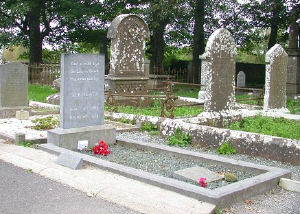 The famous Irish playwright and poet was born in Dublin in 1865. His father and brother were both painters, and the young W.B. began his artistic career at the Dublin School of Art, but by his early 20s he realized his passion was not for painting but for words. During his early literary career, he was inspired by Irish folklore; later, he became influenced by (and concerned about) politics and government in Ireland. He died in France in 1939 and was originally buried there, but in 1948 his body was exhumed and his remains were buried in the Drumcliff Churchyard in Sligo, where his grandfather had been rector in the 1800s. Yeats had requested that he be buried within sight of Ben Bulben. The inscription on his headstone was written by Yeats himself, and reads: “Cast a cold Eye/On Life, on Death./Horseman, pass by.”
The famous Irish playwright and poet was born in Dublin in 1865. His father and brother were both painters, and the young W.B. began his artistic career at the Dublin School of Art, but by his early 20s he realized his passion was not for painting but for words. During his early literary career, he was inspired by Irish folklore; later, he became influenced by (and concerned about) politics and government in Ireland. He died in France in 1939 and was originally buried there, but in 1948 his body was exhumed and his remains were buried in the Drumcliff Churchyard in Sligo, where his grandfather had been rector in the 1800s. Yeats had requested that he be buried within sight of Ben Bulben. The inscription on his headstone was written by Yeats himself, and reads: “Cast a cold Eye/On Life, on Death./Horseman, pass by.”
Jonathan Swift
 The author of the famous “Gulliver’s Travels” was born in Dublin in 1667, and served as the Dean of St. Patrick’s Cathedral for more than 30 years. While many read “Gulliver’s Travels” as a simple children’s tale, when it was originally published it was seen for the biting work of satire that it is. Swift’s other work is also heavy on the satire, including “A Modest Proposal for Preventing the Children of Poor People from Being a Burden.” Needless to say, satire on the scale that he produced it didn’t sit well with the establishment. Still, he rose to prominence in becoming the Dean of St. Patrick’s in 1713, and held that position until he died in 1745. He is buried in St. Patrick’s Cathedral in Dublin near a woman called Esther Johnson, who Swift had met when he was young (and she was younger) and served as her tutor. He wrote about her in several poems, always referring to her as Stella.
The author of the famous “Gulliver’s Travels” was born in Dublin in 1667, and served as the Dean of St. Patrick’s Cathedral for more than 30 years. While many read “Gulliver’s Travels” as a simple children’s tale, when it was originally published it was seen for the biting work of satire that it is. Swift’s other work is also heavy on the satire, including “A Modest Proposal for Preventing the Children of Poor People from Being a Burden.” Needless to say, satire on the scale that he produced it didn’t sit well with the establishment. Still, he rose to prominence in becoming the Dean of St. Patrick’s in 1713, and held that position until he died in 1745. He is buried in St. Patrick’s Cathedral in Dublin near a woman called Esther Johnson, who Swift had met when he was young (and she was younger) and served as her tutor. He wrote about her in several poems, always referring to her as Stella.
Peig Sayers
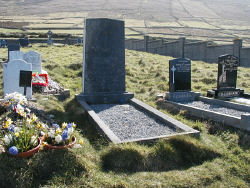 Perhaps not as famous a name as some of the others on this list, Peig was one of the most famous Irish storytellers in a country that places a high value on telling a good story. She was born in 1873 in Dunquin, and spent a good portion of her life working as a servant in the homes of members of the middle class. After she married, she moved to the Great Blasket Island and remained there until the island was abandoned in 1953. From the island, she moved directly into a hospital in An Daingean and lived there until she died in 1958. She never learned to read or write in the Irish language – she dictated most of her stories to archivists from the Irish Folklore Commission and even her autobiography was dictated to her son – but she remains one of the most beloved Irish storytellers of her time. She is buried in the Dunquin Burial Ground in Dingle.
Perhaps not as famous a name as some of the others on this list, Peig was one of the most famous Irish storytellers in a country that places a high value on telling a good story. She was born in 1873 in Dunquin, and spent a good portion of her life working as a servant in the homes of members of the middle class. After she married, she moved to the Great Blasket Island and remained there until the island was abandoned in 1953. From the island, she moved directly into a hospital in An Daingean and lived there until she died in 1958. She never learned to read or write in the Irish language – she dictated most of her stories to archivists from the Irish Folklore Commission and even her autobiography was dictated to her son – but she remains one of the most beloved Irish storytellers of her time. She is buried in the Dunquin Burial Ground in Dingle.
John F. McCormack
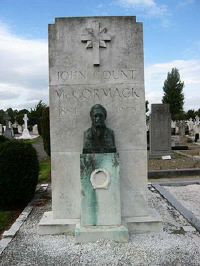 Ireland may be famous for its poets and storytellers, but McCormack is perhaps the country’s most famous opera singer. He was born in 1884 in Athlone and with his operatic debut at London’s Covent Garden in 1907, he made history as the theatre’s youngest principal tenor. He toured the world, and was one of the most beloved tenors of the early 1900s. In fact, he actually became a naturalized citizen of the United States in 1917 and even donated money to the US war effort. But in 1927 he moved back into a home in County Kildare (while keeping apartments in London and New York) and living an extravagant lifestyle. Toward the end of his career, he focused more on Irish ballads than opera, and his final performance was at the Royal Albert Hall in London in 1938. He died in 1945, and is buried in Deansgrange Cemetery in Dublin.
Ireland may be famous for its poets and storytellers, but McCormack is perhaps the country’s most famous opera singer. He was born in 1884 in Athlone and with his operatic debut at London’s Covent Garden in 1907, he made history as the theatre’s youngest principal tenor. He toured the world, and was one of the most beloved tenors of the early 1900s. In fact, he actually became a naturalized citizen of the United States in 1917 and even donated money to the US war effort. But in 1927 he moved back into a home in County Kildare (while keeping apartments in London and New York) and living an extravagant lifestyle. Toward the end of his career, he focused more on Irish ballads than opera, and his final performance was at the Royal Albert Hall in London in 1938. He died in 1945, and is buried in Deansgrange Cemetery in Dublin.
Michael Collins
 This Irish revolutionary leader was born in 1890 in West Cork, and although his early career was that of a stockbroker in London, he eventually rose through the ranks of the Irish Republican Brotherhood to become a member of the “Supreme Council.” Collins took part in the 1916 Easter Rising, fighting in the General Post Office in Dublin and getting arrested for his part in the attack. Rather than being hanged, however, Collins was sent to an internment camp where he rose further through the leadership of Sinn Fein. He was appointed as the Minister of Finance for the Irish Republic in 1919, and later went to London to negotiate the Anglo-Irish Treaty to recognize the existence of an Irish state. Collins was killed in 1922 in an ambush organized by members of the Irish Republican Army who were opposed to the treaty which he had helped to negotiate. He is buried in Glasnevin Cemetery in Dublin.
This Irish revolutionary leader was born in 1890 in West Cork, and although his early career was that of a stockbroker in London, he eventually rose through the ranks of the Irish Republican Brotherhood to become a member of the “Supreme Council.” Collins took part in the 1916 Easter Rising, fighting in the General Post Office in Dublin and getting arrested for his part in the attack. Rather than being hanged, however, Collins was sent to an internment camp where he rose further through the leadership of Sinn Fein. He was appointed as the Minister of Finance for the Irish Republic in 1919, and later went to London to negotiate the Anglo-Irish Treaty to recognize the existence of an Irish state. Collins was killed in 1922 in an ambush organized by members of the Irish Republican Army who were opposed to the treaty which he had helped to negotiate. He is buried in Glasnevin Cemetery in Dublin.
Gerard Manley Hopkins
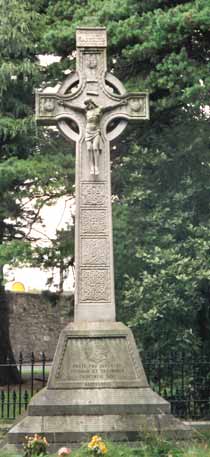 Hopkins was actually born in England in 1844, and rose to prominence only after his death as one of the best-known poets of the Victorian era. He is particularly known for something called “sprung rhythm,” which was intended to mimic natural speech more closely than written poetry of the time. Hopkins claimed this rhythm was found in English folk songs and spoken verse, and in his own poems he used accent marks to signal to the reader which syllables were to be held and which were to be clipped short in order to achieve the desired effect. Still, for all this effort, his poetry was almost unknown until after his death in 1889 – most of his work was published posthumously. Hopkins is buried in the Jesuit plot of the Glasnevin Cemetery in Dublin, having become a Jesuit priest in 1882.
Hopkins was actually born in England in 1844, and rose to prominence only after his death as one of the best-known poets of the Victorian era. He is particularly known for something called “sprung rhythm,” which was intended to mimic natural speech more closely than written poetry of the time. Hopkins claimed this rhythm was found in English folk songs and spoken verse, and in his own poems he used accent marks to signal to the reader which syllables were to be held and which were to be clipped short in order to achieve the desired effect. Still, for all this effort, his poetry was almost unknown until after his death in 1889 – most of his work was published posthumously. Hopkins is buried in the Jesuit plot of the Glasnevin Cemetery in Dublin, having become a Jesuit priest in 1882.
Brendan Behan
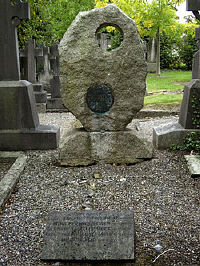 This Irish writer was born in Dublin in 1923, and contributed to the world of Irish literature in several ways – he wrote poetry, short stories, novels, and plays. And all of this came after leaving school at the age of 13 to paint houses for a living. Behan was politically active throughout his life, and joined the Irish Republican Army at the age of 16. That same year, he even got arrested in Liverpool for attempting to blow up the docks. He spent three years in prison then, and later spent 14 more years in prison for the attempted murder of two detectives. After that second stint behind bars, he remained supportive of the IRA but no longer took part in any military activities. He wrote about his prison time, as well as many other things, in his many literary works. But he didn’t adjust well to the limelight which came with being a famous writer, and was both a diabetic and an alcoholic. He died at the age of 41 in 1964, and is buried in Glasnevin Cemetery in Dublin.
This Irish writer was born in Dublin in 1923, and contributed to the world of Irish literature in several ways – he wrote poetry, short stories, novels, and plays. And all of this came after leaving school at the age of 13 to paint houses for a living. Behan was politically active throughout his life, and joined the Irish Republican Army at the age of 16. That same year, he even got arrested in Liverpool for attempting to blow up the docks. He spent three years in prison then, and later spent 14 more years in prison for the attempted murder of two detectives. After that second stint behind bars, he remained supportive of the IRA but no longer took part in any military activities. He wrote about his prison time, as well as many other things, in his many literary works. But he didn’t adjust well to the limelight which came with being a famous writer, and was both a diabetic and an alcoholic. He died at the age of 41 in 1964, and is buried in Glasnevin Cemetery in Dublin.
Cecil Frances Alexander
 This composer of hymns may not be a household name, but chances are you’ve heard her work. She was born in 1818 in Dublin, and wrote verse as early as her childhood. She is said to have written more than 400 hymns throughout her life, arguably the most famous of which is “All Things Bright and Beautiful.” Alexander also wrote the Christmas carol, “Once in Royal David’s City.” Her book of hymns for children was already in its 69th edition by the late 1800s, and she even used the proceeds from her early publications to help fund a school for the deaf and dumb in Strabane. She died in Dublin in 1895, and is buried in the City Cemetery in Londonderry.
This composer of hymns may not be a household name, but chances are you’ve heard her work. She was born in 1818 in Dublin, and wrote verse as early as her childhood. She is said to have written more than 400 hymns throughout her life, arguably the most famous of which is “All Things Bright and Beautiful.” Alexander also wrote the Christmas carol, “Once in Royal David’s City.” Her book of hymns for children was already in its 69th edition by the late 1800s, and she even used the proceeds from her early publications to help fund a school for the deaf and dumb in Strabane. She died in Dublin in 1895, and is buried in the City Cemetery in Londonderry.
John Boyd Dunlop
You may not know this man’s name, but you’re very familiar with his invention: Dunlop is one of the inventors of the pneumatic tire. Born in Scotland in 1840, Dunlop originally studied to become a veterinary surgeon – and even worked as a vet for almost ten years. He moved to Belfast in Northern Ireland in 1867, and then in 1887 he made the first pneumatic tire for – of all things – the wheel of his son’s tricycle. When it worked, he patented it, unaware that another Scottish inventor had already patented the idea 40 years prior. Still, he went on to found the Dunlop Tyre Company, still in existence today. Dunlop died in Dublin in 1921, and is buried in Deansgrange Cemetery in the capital city.
Frank O’Connor
This Irish author was born in Cork in 1903, and during his lifetime published over 150 short stories and other works. Early in his life, O’Connor was involved with the politics of the time – he participated in the Irish Civil War on the Anti-Treaty side, and was even imprisoned in an internment camp for a year. When he got out, he worked as a teacher of the Irish language, a theatre director, and a librarian. He later got involved with the Abbey Theatre in Dublin, become its managing director in 1937. In the 1950s, he spent time teaching in the United States and published some short stories in The New Yorker. After suffering a stroke in California in 1961, O’Connor returned to Ireland. He died from a heart attack in 1966 in Dublin, and is buried in Deansgrange Cemetery in that city.
Flann O’Brien
This is likely to be the name you’re familiar with, although it’s a pen name – the real person behind Flann O’Brien was Brian O’Nolan. He was born in Strabane in 1911, and worked as a civil servant for the Irish government for much of his life. At that time, working as a civil servant was a much more political position than it is today – so it is easy to see why O’Nolan used a pseudonym. In fact, he’s famous for having used lots of them, sometimes writing letters to the editor to criticize his own writings. With all of these different identities, it’s impossible to come up with a truly complete catalog of all his works. He did write several novels, and also spent time as a journalist working for The Irish Times (writing in both English and Irish). He died in 1966 in Dublin, and is buried in Deansgrange Cemetery.
Ernest Walton
Ireland’s only Nobel Prize in science belongs to Ernest Walton, who won the prize in 1951. He was born in County Waterford in 1903, and studied at both Trinity College and Cambridge University. It was during his graduate years at Cambridge in the 1930s that he worked with another physicist on the experiments that would eventually lead to the Nobel Prize 20 years later. He became a Trinity College fellow in 1934, and in 1946 became a professor. In 1951 his earlier work at Cambridge was rewarded with a Nobel Prize in Physics for building a machine that would split the nucleus of a lithium atom. He died in Belfast in 1995, but shortly before he died he presented his Nobel medal to Trinity College. Walton is buried in Deansgrange Cemetery in Dublin.
And if none of these folks is famous enough for you, remember that the tomb of Saint Patrick can be found near the south wall of Downpatrick Cathedral in Carlow, and the tomb of Saint Valentine is in the Whitefriars Street Church in Dublin!
Thanks to Find-A-Grave and Poets’ Graves for many of the grave photographs